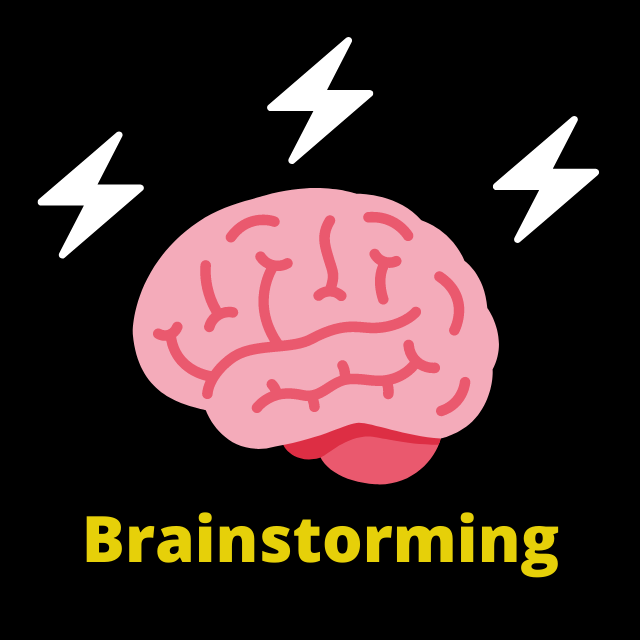Brainstorming-Meaning, Types, and Uses
Brainstorming is a technique used to generate new ideas by allowing the mind to go off on tangents. There are different types of brainstorming that this article will discuss, including various uses of brainstorming.
To create more and better ideas, you must separate creation from evaluation, come up with lots of ideas first, and then judge their worth later. However, most people evaluate too soon and too often, which means they create less than they could be making if they allowed themselves to come up with many ideas before deciding which ones were good or bad.
Brainstorming is an easy way for people who have never tried it before to get into the habit of generating as many solutions as possible.
Lets find out more below! Also, as you read, keep in mind that we can provide you with help with writing essays, hence saving you all the hassle of college essays!
Defining brainstorming and the different types of brainstorming
Brainstorming is a technique used to help generate new ideas. Brainstorming is done in groups or individually with the intention to produce numerous and diverse ideas. It allows the mind to go off on tangents as there are no rules or restrictions, meaning you can give any idea a voice. There are different types of brainstorming which will be discussed below.
1. Open Brainstorming
This type of brainstorming allows everyone to contribute ideas without any constraints. It’s done in an unconstrained environment with a lot of enthusiasm. This means that there are no rules on what can be said or contributed during the session. Also, people don’t have to worry about whether they sound silly because they are encouraged to participate and give any idea a voice. However, this can lead to chaos, so it’s important that the session’s moderator steps in at times and brings some order to allow everyone to contribute but still be productive.
2. Structured Brainstorming
This is another common type of brainstorming which uses a set format that allows creativity to flourish. The structure usually begins with the problem or situation and then moves on to brainstorm for potential solutions. However, there is no idea too silly because all ideas are welcomed. It’s important to record the ideas being contributed so they can be reviewed later on. This type of brainstorming allows people to work independently and in teams as they put in their ideas at the initial stages and then work on them later. They may also disagree with one another, and this is all part of the process, which helps generate even more ideas.
You may also be interested in most appropriate college extracurricular activities
3. Controlled Brainstorming
This type of brainstorming is where every idea contributed must be approved by a group leader or some other person with authority. Every thought must be approved before it can be considered to give a voice to an idea and move forward with it. The brainstorming session is also planned in advance, so the moderator knows precisely what to expect from everyone involved in the session. This provides structure leading into the session, which helps plan out how people will participate in the session.
4. Group Brainstorming
This type of brainstorming is where two or more people put together their ideas collectively to generate new ones. They may also review each other’s ideas, improving upon them through discussion and further development. This process usually starts with individual contributions and then shares them with the rest of the group. However, your idea may be hidden from the other group members so that they can’t affect how you think about it. They are then reviewed anonymously, which allows the person contributing to defend their idea more easily and without fear of being criticized or judged for any reason. This is a process that develops stronger ideas by working together and generating new ones.
5. Brainwriting
Brainwriting is the process whereby ideas are contributed on a sheet of paper in writing by each group member without showing it to anyone else in the group. They can then go away and work on their idea so that when they return, everyone can discuss what they have written down. This allows you to share your idea with the group openly through a discussion but get individual thoughts simultaneously. Each group member contributes their ideas on a separate piece of paper first to concentrate on them before sharing them with other members of the group. This is important because some people may choose not to have input in discussions which would mean they would be left out.
6. Choral Brainstorming
This is a vocal brainstorming session in which the group works together to generate ideas and solve problems. One person talks for 10-15 minutes, while everyone else listens and contributes ideas freely at any time. This encourages more participation in the session and moves it forward at a good pace. A person is assigned to do the talking in each session, or else it’s done by drawing lots, which is another way of being fair and ensuring that everyone has an equal say on the subject matter. However, this can leave some people feeling left out or intimidated if they don’t feel comfortable speaking up in groups.
7. Reverse Brainstorming
This brainstorming session takes the problem as the starting point instead of the problem statement. Reverse Brainstorming is used to problem solve by asking a question on something but not answering it and then moving on to another related problem you would like solved. It is also done in teams so that people can work together with others who are facing similar issues.
8. Round Robin Brainstorming
This is a problem-solving brainstorming session in which people take turns working on the problem or issues, and they all contribute ideas freely as each person has their turn. In round-robin problem solving, everyone in the group takes part by having their say one after another. The problem is changed several times throughout this session as everyone will be thinking about something new.
9. Mind Mapping
This problem-solving brainstorming session is used to help organize an idea or problem by utilizing each member’s expertise. This gives you the chance to understand how everyone deals with certain issues and how they think about them. It also helps improve problem-solving skills, creativity, and teamwork as well.
People use this technique because it helps them hierarchically organize their ideas. In mind mapping, a problem or problem statement is placed in the center of a piece of paper. Then the idea branches off from this, which allows everyone to contribute openly to the problem-solving session while focusing on their own ideas simultaneously.
Brainstorming can be done at various times and in any situation, including a formal meeting for brainstorming with just the people directly involved.
It’s not necessary to have everyone in a business or organization involved. Still, it’s also not recommended that only one person does the brainstorming because this may result in personal choices being made that favor one person over another.
It allows for more ideas to be put forward with a group of people involved and gives everyone’s idea a chance.
Brainstorming can also be done on the spot instead of going away from a meeting and coming back later. There is no right or wrong time to do this, but it’s good for making sure you don’t forget the ideas put forward.


How to use brainstorming in personal life and business setting
Brainstorming uses in a personal life include:
1. Brainstorming is a great tool for generating ideas and conversations with other people.
2. Brainstorming can be used to identify goals and resolutions for the new year.
3. Brainstorming can help generate interesting ideas for a new hobby.
4. Brainstorming can generate new ideas, boundaries, or limits to make work more manageable with less time wasted on unimportant tasks and activities.
5. Brainstorming provides you with a way of thinking that isn’t constricted by preconceived notions of what’s possible, what isn’t, and where to begin.
6. Brainstorming can help you create a plan of action built on the strength of your ideas instead of trying to fix someone else’s wrongs.
7. Brainstorming can provide you with some much-needed perspective when things in your life seem overwhelming or confusing.
8. Brainstorming can help you feel connected and centered with yourself and your creativity.
9. Brainstorming can create the opportunity to meet new people or re-connect/build relationships with old friends, family, coworkers, etc.:
Our Scholarship Essay Writing Service can help you get that scholarship!
Brainstorming uses in a business setting include:
1. Brainstorming is used by companies when they need to come up with new ideas for a product or service.
2. Brainstorming is often used as a part of strategic planning so that you can create a business strategy (plan) that focuses on the strengths of your company and the needs/wants of others.
3. Brainstorming helps to maximize creativity and minimize the risk of group-think or things staying ‘stuck’ because they’ve always been a certain way.
4. Brainstorming helps you to focus on what is possible versus only what will likely happen in the future.
5. Brainstorming can help an organization identify strengths (and weaknesses) as well as find solutions to those weaknesses.
6. Brainstorming helps you identify new ways of doing things, which might be better or more effective than the old methods.
7. Brainstorming can help you find creative solutions when problems arise in business and work life.
8. Brainstorming is used to generate unique ideas and discuss how to solve problems and make decisions more efficiently.
9. Brainstorming is used to help an organization identify new clients/customers or customer needs.
10. Brainstorming helps you think out of the box without being tied down by conventional ways of thinking so that you can produce solutions for your company’s products, services, or processes that will ultimately help your organization to grow.
11. Brainstorming helps you create new partnerships with other businesses, organizations, etc.:
12. Brainstorming is most effective when it’s holistic – which means that the whole business and all its employees are involved in creative decision-making:
13. Brainstorming can help you identify new customers for your company’s products or services.
14. Brainstorming helps you to create unique ways of selling your products or services
Tips for having successful brainstorming sessions with others
Some tips for having a successful brainstorm session are as follows:
1. Make sure you’re in a comfortable, open-minded environment where people feel free to speak their minds without negative consequences like shame, intimidation, or ridicule.
2. Be constructive by staying on the topic you’re brainstorming about and being aware of any blocks to full participation.
3. Set aside enough time so that no one is rushed to generate ideas.
4. Encourage everyone to speak up and share their ideas even if they seem silly or outlandish at first glance.
5. Reflect on the effectiveness of your brainstorming sessions by asking others what they thought about the process and what they learned from it:
6. Be adventurous in your brainstorm session by telling the participants to take risks and go outside their comfort zones:
7. Take notes during your brainstorming session so that you can capture everyone’s ideas.
8. Be flexible with the brainstorming sessions first, but then make sure you determine how you’ll follow up on everything discussed.
9. Make sure you follow up on your brainstorming sessions with others by prioritizing the generated ideas and solutions.
10. Make sure you celebrate new ideas and accomplishments; take time to reward yourself for any progress made.
11. Be curious about what others come up with in a brainstorming session so that you can evaluate everything and identify other ways to improve brainstorming sessions.
12. Be creative in your brainstorming and don’t let concerns about money or time get in the way of new ideas or solutions:
13. Know that you’re not always stuck with what’s currently happening – you can think outside the box when it comes to business, work, social life/relationships, etc.
14. Be respectful of others’ ideas and opinions while brainstorming with them
Brainstorming sessions can promote teamwork, and effective discussion among everyone involved so that a business or team can grow and increase its effectiveness in the long term.


List of resources that can be used to learn more about Brainstorming
1. Brainstorming for Beginners: A Practical Guide to Getting the Best Out of Your Brain
2. The Little Book of Common-Sense Investing
3. The Book on Rental Property Investing
4. A Beginner’s Guide to the Stock Market
5. Rich Dad Poor Dad
6. Google Books has a multitude of resources from other people’s experiences that you can read about brainstorming online at the library:
7. Wikipedia has a ton of information about brainstorming, not just in terms of its definition but some tips on how to make it more effective as well; one person’s experiences with brainstorming
You may also be interested in All Girls Schools
Examples of what people have done using brainstorming techniques in business
Example 1
When Air Canada was looking for new ways to increase their share of the market for flights between London and Toronto, they decided they would have to develop some new ideas. They started a brainstorming session and found that rather than the traditional approach, people interested in flying between London and Toronto would be more responsive if they invested money to publicize themselves as sponsors of the Canadian Grand Prix or opera in London. The result was that Air Canada became one of the most talked-about companies in Toronto and their share of the market increased substantially.
They could have tried many other things, such as making changes to the way flights were operated or introducing a frequent flyer scheme, but they chose to do something different, and it worked.
Example 2
The following example concerns management consultants who a company called in to talk about business opportunities. One of the options was to use computers, but as they weren’t sure how best to do this, the management consultant suggested using a brainstorming session. This is because everyone throws out ideas, and then everyone votes for their favorite one.
The person who came up with the winning idea said that they thought if they printed out all of their invoices on a computer and then added them together, they would tell at a glance how much money the company was making.
Example 3
The last example of brainstorming is related to using computers. A man looking after IT for a small company had some problems with his machinery, and it was going wrong all the time, which meant that he had to call out technicians all of the time. One day he decided to try brainstorming and develop ideas as to how best to solve this problem.
While brainstorming can be challenging, it’s a necessary part of problem-solving.
Brainstorming is a process that requires focus, openness, and communication. When these three elements are put together in an environment where ideas can be shared freely without judgment, problem-solving becomes a collaborative effort that can lead to innovative solutions and increases the likelihood of success.
Brainstorming is used in many business meetings because it allows everyone who participates to feel like they can contribute their ideas regardless of rank or seniority. Whether you work for a Fortune 500 company or a small business, brainstorming sessions are an essential problem-solving tool that can help you generate new ideas in a safe and creative environment.


Tips for running a successful brainstorming meeting
1. Have everyone present at the meeting on time to have no downtime while waiting for latecomers.
2. Have a clear agenda of the items that need to be covered during the meeting and stay focused on these issues without wandering off onto other topics.
3. Keep track of time so that meetings don’t run too long as this can cause some people to lose interest or even fall asleep.
4. Encourage everyone who attends the meeting to feel comfortable putting forth their ideas without judgment and ensure that all of the suggestions are documented so that they can be considered after the session is over.
Brainstorming is often used before problem-solving sessions because it helps generate new ideas about solving the problem at hand. This process should always be conducted with an open mind and in an environment that is free from judgment.
How to join Harvard or Stanford may also interest you!


I‘m a freelance content and SEO writer with a passion for finding the perfect combination of words to capture attention and express a message. I create catchy, SEO-friendly content for websites, blogs, articles, and social media. My experience spans many industries, including health and wellness, technology, education, business, and lifestyle. My clients appreciate my ability to craft compelling stories that engage their target audience, but also help to improve their website’s search engine rankings. I’m also an avid learner and stay up to date on the latest SEO trends. I enjoy exploring new places and reading up on the latest marketing and SEO strategies in my free time.







